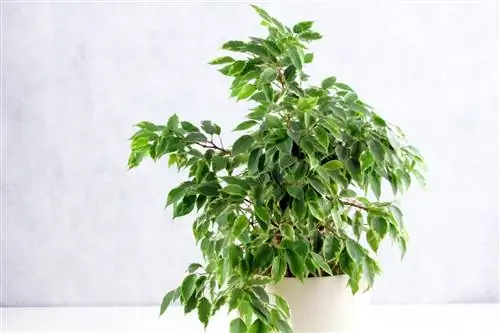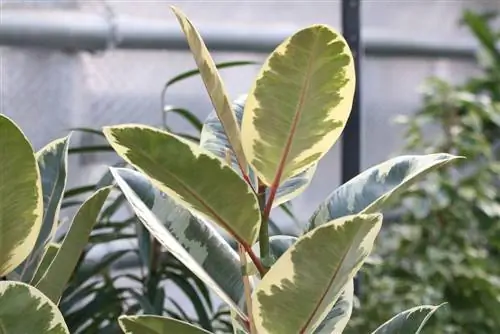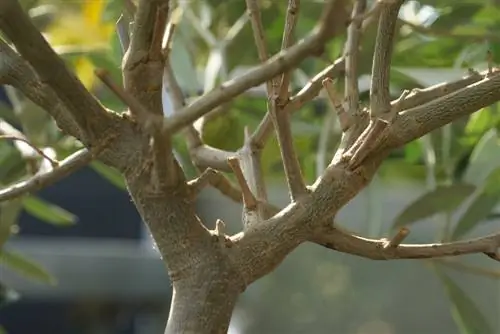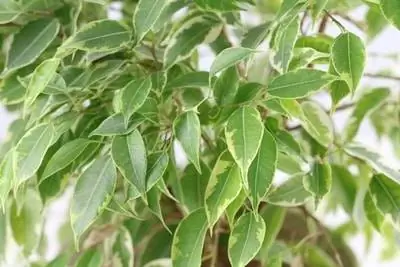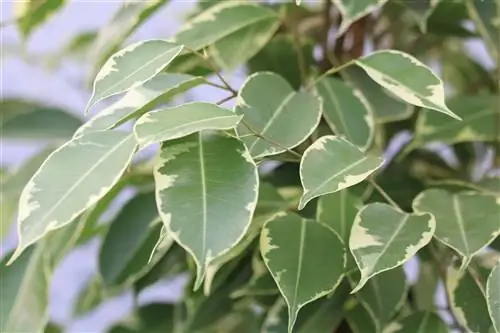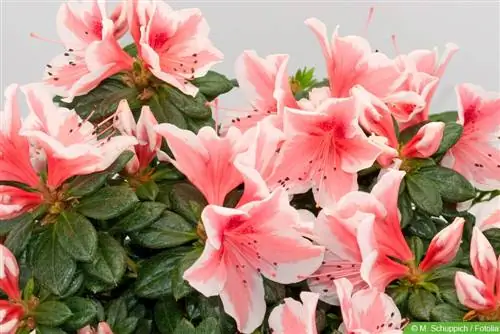- Author admin [email protected].
- Public 2023-12-17 03:39.
- Last modified 2025-06-01 06:48.
The birch fig (Ficus benjamina - often also "Ficus"), which is widespread in the tropical regions of Asia and Australia, decorates many living rooms with its colorful or delicate green leaves. However, the indoor tree is not only extremely decorative, but also very sensitive. It reacts to the slightest care mistakes or an inadequate location by dropping leaves. However, this is a protective mechanism that is intended to ensure the survival of the tree.
Why leaves fall at all
If the Ficus benjamina sheds its leaves, it starts its emergency program: some environmental influence orAny care measure causes the plant to feel uncomfortable and therefore switches to survival mode. By shedding the leaves - which often turn yellow or brown beforehand - the tree ensures that it evaporates less water and also has to transport less energy to this part - the ficus is running its emergency program, so to speak.
If you find and eliminate the cause of the leaf drop, even an already bare indoor tree can sprout again and shine in all its beauty - of course only if there is still life in it. You can find this out quickly by scratching the trunk a little: If a milky sap comes out(Caution! This is poisonous!), resuscitation measures are worthwhile.
Tip:
If your ficus loses some older leaves in the fall, you don't have to worry yet. Like any other deciduous tree, the foliage is renewed from time to time. If there are only a few fallen leaves and the ficus also produces new ones, no countermeasures are necessary.
The most common causes of leaf drop
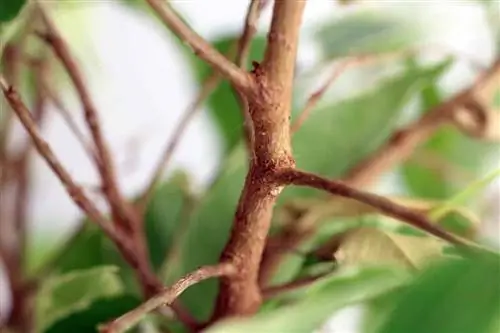
The ficus is a real mimosa: if it is too cold, it sheds its leaves. On the other hand, if it's too warm for him, too. You shouldn't water it too often, but also not too little. It doesn't like a location that is too dark, but neither does it like intense midday sun. There are many reasons for the leaves to fall off. Typically the foliage turns yellow before falling, but sometimes the ficus loses green foliage. This is always a warning sign, especially if the apparently he althy leaves fall in large numbers and young leaves are also affected. Quick action is necessary, otherwise the plant may die.
Tip:
Many indoor gardeners reach for scissors when the plant is weak or ailing and cut it back. However, pruning is not an adequate method of healing - it only further weakens the already attacked plant. Instead of scissors, grab a magnifying glass and intensively search for the cause. Once this is found, it can be eliminated. As a result, the ficus usually recovers quickly.
Inappropriate location
The Ficus benjamina is extremely sensitive to its location: in fact, disruptive factors in this regard are among the most common causes of leaf drop. There are several options that limit the well-being of the indoor tree.
Sudden change of location
The faithful ficus has a very difficult time coping with a sudden change in location. For example, if you buy a new ficus and place it in your home, you first have to expect the tree to protest. Since it doesn't like this change - where it may have been transported through wind and weather, put into a car and cleared out again - it will shed leaves. The only thing that helps here is to make the move as pleasant as possible for the ficus (e.g. you shouldn't take it outside in winter or when it's raining, but choose the warmest weather possible when buying it) and then show a lot of patience. Care for your ficus carefully and it will recover sooner or later.
Tip:
By the way, the ficus reacts to simply turning it. You can prevent this by, for example, marking the previous sunny side when repotting and putting the tree back up exactly as it was before. After such an action it will shed leaves anyway as it first has to cope with the shock of being repotted. But here too, with patience and good care, you can ensure that your ficus will soon get better again.
If the ficus does not feel comfortable in its location
While you have to expect leaf fall after a sudden change of location and only “treat” it with patience, you should look for a new place for your birch fig if the following causes occur. It reacts very sensitively to disturbing factors such as:
- Draft
- Cold (especially cold roots)
- too much heat / heat accumulation (especially in winter in front of a heater)
- Lack of light / a location that is too dark
- Burns from direct sunlight
Specimens that are directly in front of heaters and those that are in the immediate vicinity of windows or doors that are often opened are particularly at risk. This applies, for example, to locations in front of balcony or patio doors - here there is often a draft that the indoor tree is not at all comfortable with. Instead, you should pay attention to these factors when choosing the location, then your ficus will soon feel better and develop new foliage.
The optimal location for a Ficus benjamini:
- bright to sunny
- Sun in the morning hours in particular is an advantage
- avoid intense light during midday
- or shade ficus in such a location
- variegated ficus needs more sun
- warm all year round with temperatures above 15 °C
- no drafts
Tip:
Even if the location itself is perfect, the Ficus benjamina does not like “cold feet” - i.e. cold coming from below - at all and reacts to this by shedding its leaves. So don't place the plant with the cold-sensitive roots directly on the stone floor, but rather on a saucer, for example made of wood, cork or Styrofoam, and check the location for any cold bridges.
Shedding of leaves in winter
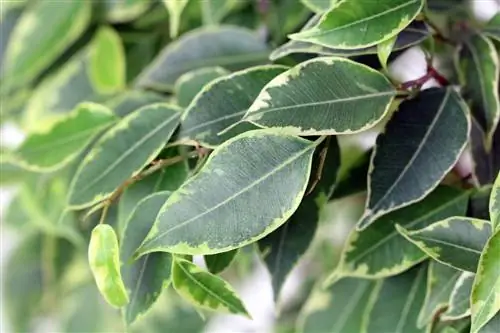
If the ficus drops its leaves in winter, in many cases there is a lack of light behind it. After all, it is a tropical plant whose homeland is warm and sunny all year round. However, the winter light in our latitudes is far from enough for the ficus. So that he still feels comfortable, you should use these measures in winter:
- bright, preferably sunny location directly next to a window
- If possible, windows with a southern orientation
- If necessary, installation of plant lamps
- Do not place the Ficus directly in front of a heater
- and not in front of a window/door that is frequently opened for ventilation
- Make the ficus a little cooler
- water and fertilize less often
The last two measures ensure that the indoor tree goes into a kind of hibernation. During this time the roots are dormant, so the above-ground parts also need less light. Of course, you should also water and fertilize less. If this is not possible (for example because there is no suitable space), the ficus needs additional artificial light. LED plant lamps are best suited here as they do not emit any heat.
Care errors
In addition to an unsuitable location or changing it, various care errors lead to the birch fig dropping its leaves. For example, incorrect watering (too much or too little) is very often the cause, but insufficient or too frequent fertilization and a lack of air humidity are also possible reasons.
Incorrect watering
When it comes to watering, there are exactly two options for a leaf-dropping Ficus: Either you water the indoor tree too often or too little, so that the plant suffers from dryness. In general, you should only water a birch fig sparingly as it is very sensitive to excessive moisture. Place the plant in a pot with a sufficiently large drainage hole at the bottom so that excess water can drain away quickly. Good drainage at the bottom of the pot with a layer of pebbles, expanded clay or pottery shards is also beneficial. Also choose a loose, well-drained substrate with as little peat as possible - this quickly compacts the potting soil and absorbs too much water.
How to water the Ficus benjamini correctly:
- Watering about every 14 days
- rare in winter
- carry out a finger test before each watering
- Substrate should be superficially dry
- as well as about two to four centimeters deep
- Don’t let the root ball dry out completely
- water with low-lime, room temperature water
After watering, you should immediately remove excess water from the planter or saucer so that the ficus does not get “wet feet”.
Waterlogging
If the indoor tree is permanently too moist or too wet, the dreaded waterlogging occurs. The roots initially begin to rot until they are no longer able to supply the above-ground components with water and nutrients. Paradoxically, the ficus then seems to dry out - the leaves turn yellow or brown, individual branches and twigs wither and finally the leaves are completely shed. If you now water the plant extra (because you think the tree is drying out), its death warrant is signed. When it comes to waterlogging, rescue measures are rarely successful anyway, but you can try this:
- Unpotting Ficus
- remove old substrate completely
- Check roots
- cut away rotten roots
- Repot the ficus into a new pot and fresh substrate
- If necessary, remove dried plant parts above ground
- but don't cut back the ficus!
If the immediate aid measures described are not successful, you can only propagate the sick ficus using cuttings.
Yellow leaves as a warning for waterlogging
The threat of waterlogging becomes noticeable early on. In this case, the leaves turn yellow before they are shed, and newly developing young leaves also look very light and rather yellowish. This coloring is often a sign of chlorosis, an iron deficiency. However, this cannot be eliminated by simply fertilizing with an iron-containing fertilizer - the rotting roots are simply no longer able to adequately supply the leaves. So repot the sick ficus in fresh, dry substrate and water only very moderately for a while. By the way, yellow leaves can occur due to iron deficiency even if you water with hard water - lime hinders the absorption of iron.
Lack of humidity
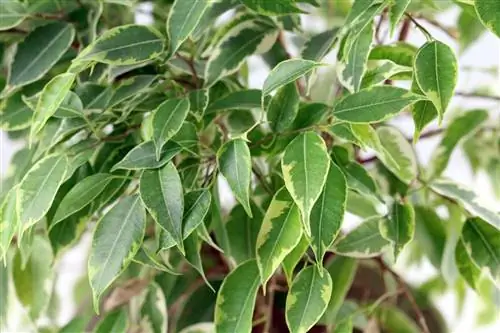
Although a ficus should only be watered moderately and under no circumstances should it be overwatered, it still needs a lot of moisture: As a tropical plant, the indoor tree depends on high humidity and warm temperatures at the same time. Incidentally, this is also the reason why a ficus should not be placed near a heater in winter: the air is very dry here and heat builds up often.
Dry air, however, can be remedied quite easily: simply spray the ficus regularly with room temperature and stale water from a spray bottle with a fine mister. This also has the pleasant side effect that pests such as spider mites - which prefer to settle in a dry and warm climate - do not appear.
Incorrect fertilization
Like any other plant, the birch fig needs nutrients to grow and stay he althy, which must be supplied with a suitable fertilizer. However, tact is required because the ficus reacts very sensitively to over-fertilization or over-s alting of its substrate. To avoid resulting leaf drop, it is best to fertilize as follows:
- Use green plant fertilizer
- dilute the recommended dose by half
- fertilize every two weeks between March and September
- between October and February every six weeks
- never fertilize on dry substrate
- Use liquid fertilizer dissolved in irrigation water
- or water after fertilizing
If the dropped leaves are noticeably pale with dark veins, then there is a nutrient deficiency caused by a lack of fertilization or the wrong fertilizer.
Tip:
Do none of the causes described apply to your ficus? Then take out a magnifying glass and examine the plant for any sucking or stinging pests such as spider mites, thrips, mealy bugs, scale insects or aphids. When infested, the leaves turn yellow and are eventually dropped.

